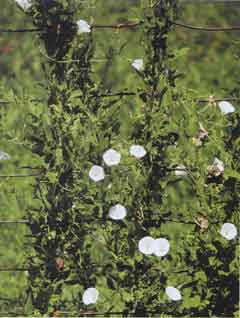(Convolvulus arvensis)
Description: Field Bindweed, also commonly referred to as "Creeping Jennie" or "Pea Vine", is a perennial reproducing by seed and underground rhizomes. The fleshy, extensive root system is wide spreading and deep penetrating. The roots may extend to a depth of 20 to 30 feet into the soil. The white rhizomes spread every direction from the plant. It may deplete the soil of moisture and reduce crop yields. The plant forms a mat on the soil surface with prostrate stems 2 to 7 feet long. The smooth, slender stems have the ability to climb short distances. The leaves are alternate, simple, petioled, and vary in size and shape according to environment. It is frequently confused with wild morning glory. The flowers which occur from May to August are white or pink, funnel-shaped, and are 2/3 to 1-inch long and ¾ to 1-inch across. They are borne on long flower stalks in the axils of the leaf and are usually single. The egg-shaped capsule bear 1 to 4 dull, dark, grayish-brown seeds. The seeds are rough-coated with 2 flat sides and one side rounded.
Distribution: Introduced from Europe, field bindweed has spread across all of the state of Iowa and Johnson County. It is most common in Northwestern Iowa. It will grow in cultivated fields, pastures, along roads and railroads, in lawns and gardens, and in waste areas. It can be found in most sites in the state except native prairie grasses, excessively shaded, or extremely wet places.
What’s the problem?: Field bindweed competes vigorously with other vegetation such as row crops or wildflowers for sunlight, water, and nutrients. It’s deep root system and long seed viability make this a difficult weed to eradicate. Crop yields and marketability can be severely decreased. Another problem with field bindweed is that small pieces of rhizome can reproduce or be carried to uninfested areas via mowers, farm equipment, etc.It is also easily mistaken for morning glory or other similar viney plants.
Management methods: Field bindweed can be a difficult weed to control in agricultural fields, gardens, and anywhere else it grows. Hand pulling small infestations may work, but even small ( less than 1/2 inch) pieces left unpulled may resprout. Many states consider field bindweed one of their major agricultural weed pests and have done research about various herbicidal management methods. Use of herbicides may help to reduce infestations to manageable levels. Always use pesticides carefully and read the label. Other management methods are cultural, such as crop rotation, and mechanical, such as tillage with disks, plows, or cultivators. Control of field bindweed may require a combination of all these methods.


Photo courtesy of Weeds of Nebraska and the Great Plains published by Nebraska Department of Agriculture
